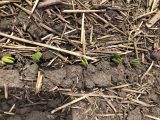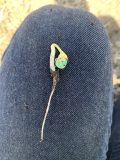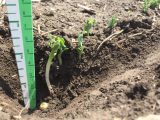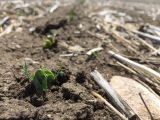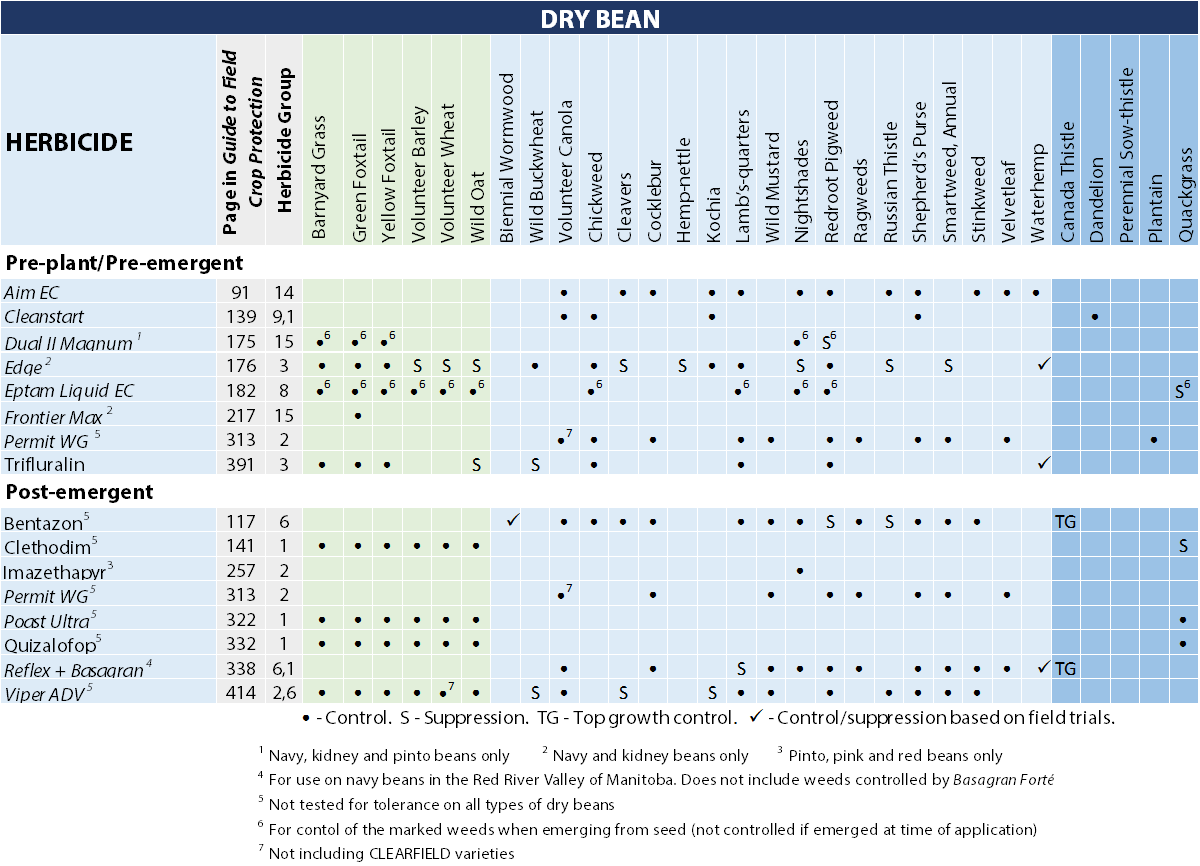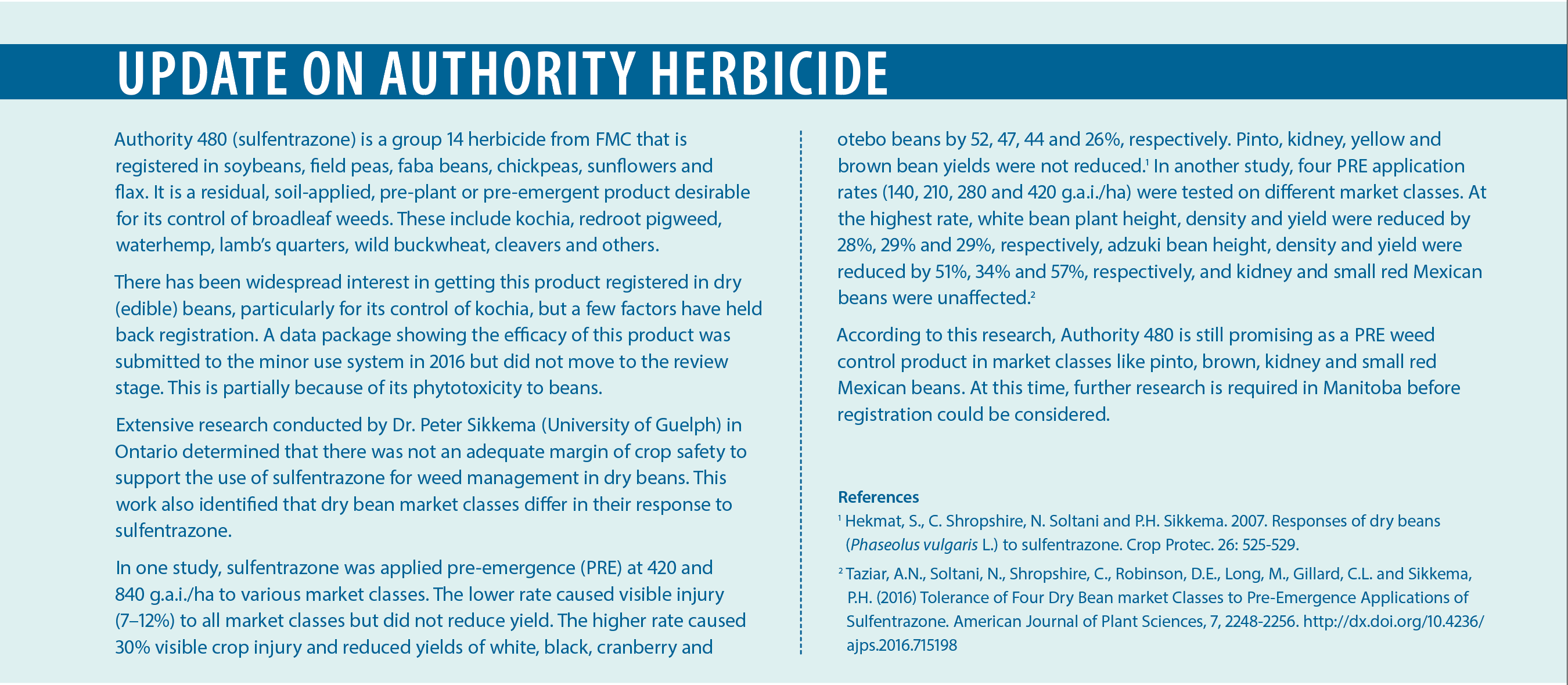May 27, 2020
- Crop update
- Dry bean seeding tips
- PRE herbicide options for soybeans
- PRE and POST herbicide options for dry beans
- Update on Authority herbicide
- Soybean seed depth assessment
- Soybean rolling decisions
- On-Farm Network update
Listen to the Bean Report here:
Crop Update
 Seeding progressed quickly last week with warmer temperatures throughout the province. Precipitation was variable over the weekend. Areas around Riding Mountain National Park and Starbuck received the most rain, while some areas received none.
Seeding progressed quickly last week with warmer temperatures throughout the province. Precipitation was variable over the weekend. Areas around Riding Mountain National Park and Starbuck received the most rain, while some areas received none.- Pea and faba bean seeding is almost complete, with crops emerging and approaching the first node stage (V1) across much of the province. Some peas are as advanced as the third to fourth node (V3 to V4) stage. As crops are emerging, keep an eye out for early season disease and insect pests like root rots, cutworms and wireworms.
- Soybean seeding is well underway and early-seeded fields have begun to emerge. Farmers who planted soybeans earlier in the month should check for signs of cold stress like twisted seedlings and delayed or poor emergence.
- Dry bean seeding began last week and is expected to advance quickly this week.
Dry Bean Seeding Tips
- Plant from mid-May to early June.
- Seed at a depth of 1.25–2 inches, placing seeds into moisture.
- Research comparing narrow and wide row widths has found a yield advantage to planting at narrower row widths (<15 inches).
- Target plant populations (live plants/ac) vary depending on market class and row spacing (see below). Adjust your seeding rate based on expected survival and seed weight.
- Check out this video tutorial by Dennis Lange on conducting a soak test to provide a more accurate estimate of seed survival for seeding rate calculations.
- Increase plant populations of pinto and navy beans grown in narrow row widths. Target 90,000 – 120,000 plants/ac for pinto and black beans, and greater than 115,000 plants/ac for navy beans.
- Inoculants have been tested in the past with little success and have not been widely commercially available. As a result, nitrogen fertilization at an average rate of 60 lbs N/ac is standard practice for dry beans in Manitoba. Research is ongoing in this area. See soil fertility guide recommendations.
- The maximum safe rate of seed-placed phosphate is 10 lbs P205/ac for narrow row widths (<15”) and zero phosphate for wider row widths.
- Minimize seed handling to reduce mechanical injury to the seed.
Soybean Pre-Plant/Pre-Emergent Herbicide Options
Dry Bean Herbicide Options
Soybean Seed Depth Assessment
- Aim for a seed depth of 0.5-1.5 inches for soybeans. Facing dry soil? If you dust it in and wait for a rain, it will need to be a good rain for the seed to take off. If you plant deeper than 1.5 inches, emergence may be delayed, uneven or seeds could be at risk of desiccation after partial germination and inadequate moisture.
- Check seed depth a few times while seeding to ensure your equipment is functioning properly and seed depth is still uniform.
- Get on your hands and knees to dig for seed carefully using a good digging tool. Gradually scrape off soil until you find seed. Measure the distance from the seed to the top of the true soil surface. This does not always equate to the top of the furrow. Check different furrows along the seeder, noting whether you are in a wheel track or not.
- Learn what your machine is doing. If your openers dig a deep furrow with big hills and/or you have wide packing wheels that push more soil over the furrow, your seed may end up deeper than intended. Rolling afterward may add even more soil to the furrow. Also check seed depth after rolling.
Soybean Rolling Decisions
Land rolling is for stony land and uneven seedbeds that pose a risk of earth tag at harvest. Rolling can be done immediately after planting to two days after planting, or post-emergence at the V1 stage when all plants are past the hook stage and not yet at V3.
Under dry, windy spring conditions, rolling after seeding increases the risk of soil erosion. If you didn’t get much rain over the weekend and dry soil is still an issue, consider avoiding rolling or waiting until V1 to roll your soybeans. + More on rolling
On-Farm Network Update
 On-Farm Network trial establishment is well underway. Pea, faba bean, dry bean and soybean trials have already been planted. Establishment of soybean trials will continue across the province this week. As the crops emerge, observations and data collection will begin.
On-Farm Network trial establishment is well underway. Pea, faba bean, dry bean and soybean trials have already been planted. Establishment of soybean trials will continue across the province this week. As the crops emerge, observations and data collection will begin.
For each trial, we take an early season plant count to get a sense of emergence and stand uniformity. This also gives us a chance to scout our trials early in the season. Plant stand information can be useful in comparing treatments where we might expect an emergence difference. An example of this is our field pea nitrogen fertility trial, comparing “starter N” (11 lb N/ac, from S15) with 30 lb N/ac and 60 lb N/ac, applied as a combination of S15 and ESN in the seed row. Early season observations and plant stand data will help us determine if the higher N rates influenced emergence, and plant stand as a result.
Stay tuned to MPSG’s social media for updates on OFN research throughout the season! Have a question about the OFN? Contact Megan Bourns, On-Farm Network Agronomist, at 204-751-0439 or megan@manitobapulse.ca.
Additional Information
- Bean App Plant Stand Assessor – use it for any crop!
- MPSG Production Resources – including insect and disease scouting calendars for soybeans, field peas and dry beans
- Weather Conditions and Reports – Manitoba Agriculture and Resource Development
- Soybean Pod Height: The Influence of Genetics, Environment and Management – article from Pulse Beat Magazine Summer 2019
Questions about your pulse and soybean crops? We’re here to help:
| Cassandra Tkachuk Production Specialist – East (204) 293-4424 cassandra@manitobapulse.ca |
Laura Schmidt Production Specialist – West (204) 751-0538 laura@manitobapulse.ca |

